
24 minute read
More Power
from 2022-02-SREMC
Addressing the Need for Rural Healthcare
By Don Gatton
Electric cooperatives power one in eight Americans — that’s 42 million people, and we don’t take that responsibility lightly. While our goal always is to provide you with safe, reliable power at an affordable price, we are also committed to supporting our local communities. Concern for Community is not just a guiding cooperative principle to display on the wall; it’s at the heart of everything we do.
Rural communities are the foundation of electric cooperatives, but the unfortunate reality is that rural healthcare faces challenges not seen in urban areas. We have fewer physicians and limited access to specialized care. As a result, rural Americans are at greater risk of dying from potentially preventable diseases like heart disease and cancer, according to the Centers for Disease Control and Prevention. That needs to change. We want our rural citizens to have access to the same quality of care found in more densely populated areas. Electric cooperatives from all over North Carolina are helping to bridge that gap by providing community donations, as well as federal grants and zero-interest loans to organizations in need. For example, with assistance from Four County EMC’s memberfunded Operation Round-Up TRUST program, a center specializing in treating addiction problems is able to make critical repairs to its residential facilities. Hospice care centers and counseling facilities can continue to provide services to those in need, regardless of a patient’s ability to pay. With collaboration between Operation Round-Up and volunteer
groups, wheelchair-accessible ramps have been built, allowing members with disabilities to maintain independent lives. Electric co-ops are supporting even larger healthcare and first responder needs through a U.S. Department of Agriculture resource called the Rural Economic Development Loan & Grant (REDLG) program. The REDLG program provides rural utilities with grants NC’s electric cooperatives and zero-interest loans to directly fund local have facilitated more than projects that create and retain employment in $35 the communities they serve. Since 2015, North Carolina’s electric cooperatives have facilitated more than $35 million in USDA financing to first responders and healthcare facilities that serve rural communities.
MILLION Bladen Healthcare, LLC, through a zerointerest REDLG loan provided by Four County in USDA financing to EMC, expanded an outpatient medical center, first responders and enabling the facility to serve more patients and healthcare facilities that provide specialized services not offered before. serve rural communities Through a similar zero-interest loan, Pender EMS & Fire was able to purchase much-needed ambulances, 911 vehicles and other equipment necessary to serve the community. Through these endeavors and others such as scholarships, teacher grants and youth programs, your electric cooperative is committed to improving the quality of life for co-op members. We are purpose-driven and community-focused yesterday, today and tomorrow.
Don Gatton is CEO for Burgaw-based Four County EMC.
FEBRUARY Quick Hits

Gridiron Grub Settle in for this year’s Super Bowl on February 13 with some next-level snacks; search for winning appetizers on carolinacountry.com/recipes.
Winter-Ready Pets
If you have pets that spend time outside, adjust food servings to provide extra calories, and check to make sure water bowls don’t freeze.
Happy Feet Stash an extra pair of socks in your car’s glove box. If your socks get wet from shoveling snow or stepping in water, you have a dry pair.
Toasty and Safe Using a woodburning fireplace this winter? Clean out ashes from previous fires, and be certain the damper or flue is open before starting a fire.
NC Co-ops Participate in National Grid Security Simulation
North Carolina’s Electric Cooperatives joined several of the state’s distribution cooperatives and more than 700 planners from across the nation in participating in this year’s bi-annual GridEx VI event, a national virtual simulation to support grid security and safety.
GridEx is the largest grid security exercise in North America and is held every two years by the North American Electric Reliability Corporation’s Electricity Information Sharing and Analysis Center. It brings together industry and government leaders to simulate cyber and physical attacks on the power grid.
The November 16–17 event provided co-op staff across the state a valuable opportunity to explore response and recovery scenarios involving simulated attacks on grid infrastructure, and to exercise cooperative crisis plans.
“GridEx is an important opportunity for our leadership and staff to practice and refine our response to crisis situations that affect our core grid infrastructure,” said Scott Brame, manager of compliance and jointly owned resources, and GridEx lead planner for North Carolina’s Electric Cooperatives. “Our participation in this simulation is a part of our deep commitment to grid security and safety, both physical and digital, and showcases our cooperative commitment to readiness.”
This year’s GridEx brought together 280 industry and government organizations in the U.S., Canada and Mexico. Electric utilities, state and federal agencies, critical infrastructure cross-sector partners and supply chain stakeholders worked through response scenarios to challenge assumptions, collaborate and enhance preparedness for current and evolving threats to the grid.
The event will return in 2023 with continued participation from North Carolina’s electric co-ops.
Celebrated Finest
Some of the winners of the 2021 Carolina’s Finest awards, featured in our November 2021 issue, are served by electric cooperatives. Two such winners were the Cape Hatteras Lighthouse (Finest NC Landmark) and Emerald Isle (Finest Getaway).
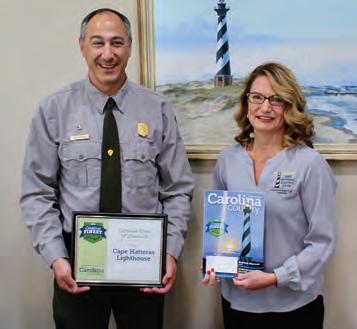
Cape Hatteras Electric Cooperative EVP and General Manager Susan Flythe with Cape Hatteras National Seashore Superintendent Dave Hallac Carteret-Craven Electric Cooperative Communications Specialist Melissa Glenn with Emerald Isle Town Manager Matt Zapp
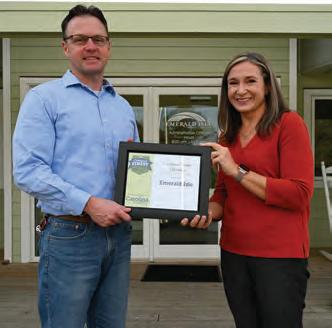
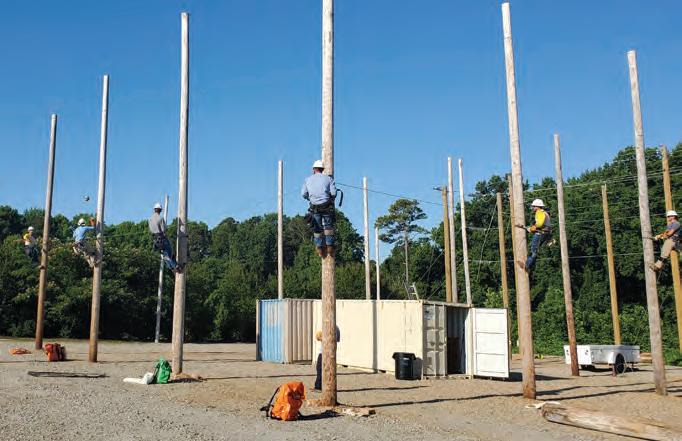
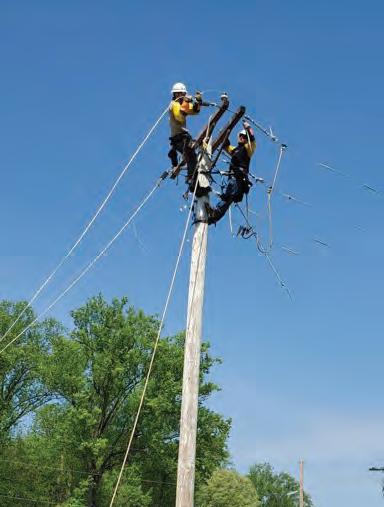
Electric Cooperative Lineworkers Gain Knowledge and Skills at Nash Community College
In 2021, 14 electric cooperative linemen completed advanced education work in the Nash Community College’s Electric Lineman Technology program. The line workers earned curriculum certificates for completing college-level credits. Teamwork and consistent training are also benefits for these students as they train with students from their sister cooperatives during each week’s class.
The program includes courses with both classroom content and practical hands-on objectives. The specially designed training field built by the North Carolina Association of Electric Cooperatives creates a training environment that allows individuals to increase skills for application when they return to their individual cooperatives. They learn skills such as overhead line construction, underground line construction and the National Electrical Safety Code. Beyond classes in line work and energy management, additional courses can be taken through the Community College System toward an associate degree such as writing and math to critical thinking, computers and communication.
Since the programs began in 1998, 23 co-op linemen have graduated with an associate degree. The community college program is supported entirely by electric cooperatives, but is also attended by linemen from Duke Energy and municipal electric systems.
In 2021, 396 co-op employees attended the NC Electric Cooperatives’ Job Training & Safety Technical Training Schools at Nash Community College, and more than 500 have registered to attend in 2022. Associate Degree
Rutherford EMC Matthew Harshman
Spring 2021 Advanced Certificate Recipients
(17 Course-Hour Credits) Pee Dee Electric Jesse Puckett Surry-Yadkin EMC Nick Newman
Summer 2021 Advanced Certificate Recipients
(17 Course-Hour Credits) Edgecombe-Martin County EMC Alton Lewis Halifax EMC Cody Pleasant Rutherford EMC Matthew Harshman
Fall 2021 Advanced Certificate Recipients
(17 Course-Hour Credits) Four County EMC Lee Bain
Halifax EMC Branden Edwards
Lumbee River EMC Joshua Oxendine Roanoke Electric Cooperative Robbie Stallings South River EMC Nathaniel Lucas Daniel Purvis
Tideland EMC Joshua Dunbar Robert Shively Tri-County EMC James Cozine
Journey To Save A Life
A casual conversation between co-workers led to a lifesaving surgery
By Catherine O’Dell
On July 13, 2021, I had the honor to be a living kidney donor for Susan Green. Susan is the wife of a South River EMC co-worker, Dana Green. One day, Dana mentioned that his wife has a rare genetic kidney disease called Focal Segmental Glomerulosclerosis, and that she would soon need dialysis and a transplant. This kind of conversation often leaves you feeling helpless, but I knew instantly that I could help. The exchange stayed in my mind and on my heart. A few days later, I asked about Susan’s blood type: A-positive, same as mine.
I couldn’t stop thinking about Susan. I did some research and found that nearly 750,000 Americans are battling end-stage renal disease, according to Kidney.org, and that more than 100,000 people in the United States are waiting for a kidney transplant. Tragically, 12 people die daily waiting for a life-saving kidney. The good news is that about 22,300 get a kidney and a new lease on life. There are approximately 6,500 transplants from living donors annually, although the majority of transplanted kidneys are from deceased donors. Organs from living donors provide a greater life span for the recipient: A kidney from a living donor lasts 12 to 20 years, while a kidney transplanted from a deceased donor lasts eight to 12 years.
These startling statistics helped me to become more focused and inspired to help. I spoke to a friend who had donated a kidney, as well as one who had received a lifesaving kidney. Both served to motivate me and were instrumental in my decision. I have been blessed with good health, and I knew that it was time to help someone else. I believe I was placed in the right place at the right time.
Once I told Dana that I wanted to be considered as a donor, she called the UNC Hospitals Jason Ray Transplant Clinic to get the ball rolling immediately.
“When Dana told me someone wanted to give me a kidney, I was so grateful, and I felt like my feet would never touch the ground,” Susan said.
The first step was a blood sample to ensure our blood type and subtypes match. We matched.
I spent two days at UNC Hospitals undergoing a series of scans and tests to ensure my kidneys were healthy and functioning properly, and to confirm that I was healthy enough to undergo surgery.
I stayed in touch with Susan every step of the way.
Once all results were returned, we learned everything looked good — except I had to lose some weight before being cleared for surgery. I started walking and dieting. It is amazing how dedicated you become when someone else’s life depends on your success. In the meantime, Susan began dialysis, a step she was hoping to avoid, but ultimately made her healthier for the surgery.
The weight and I had parted ways, and it was time for the surgery. We checked into the hospital early one morning, and by midday both of our lives were changed and we are forever bound to one another.
I spent two days in the hospital and returned to work two weeks later.
The doctors, nurses and staff at the Jason Ray Transplant Clinic are passionate about the care they provide, so much that I trusted them with my life. My life can go on without much difference, but Susan’s life is changed forever. It is this point where Susan’s story begins.
“I have been given a second chance for life,” Susan said. “I would encourage those on the transplant list to stay strong, and don’t give up! Spread the word that you need a kidney, because there are amazing people who might want to donate.”
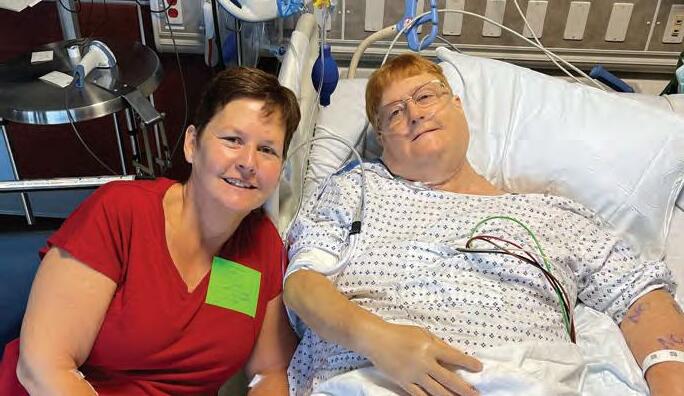
Catherine and Susan after surgery
Catherine O’Dell, CCC, is vice president of Member Services & Public Relations for Dunn-based South River EMC.
How you can help
Saving a life can be as simple as donating blood, registering to become an organ and tissue donor upon your death, or by being a living donor of bone marrow, part of your liver or one kidney. Visit donatelife.net for complete information on donation options.
Mollie Tobias
Karen Wicker (left) is the executive director of the recovery center. NC-certified Peer Support Specialists Stephanie Heck (center) and Amy Locklear are in recovery, giving them a unique perspective to help clients.
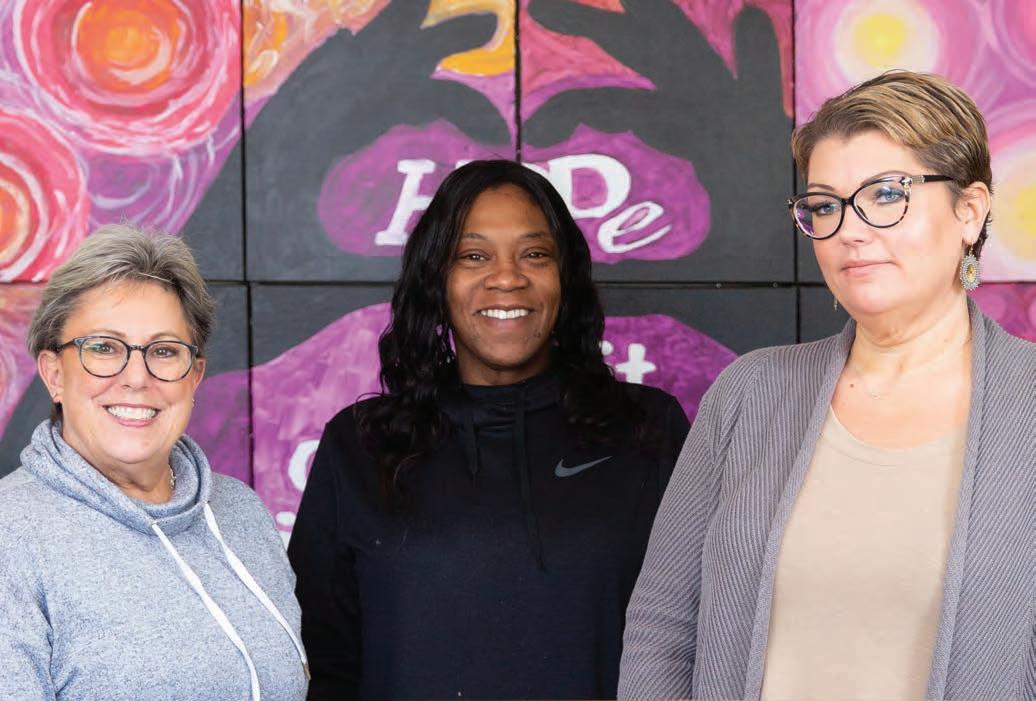
Recovery The Road to
Communities are working together By Gordon Byrd to turn the tide on the opioid epidemic

It was bitter cold, and a misty rain dogged the line of people outside a nondescript building near Cape Fear Hospital in Fayetteville.
In an archipelago of outpatient doctors’ offices that cordons the hospital, Acadia Healthcare’s Comprehensive Treatment Center is frequented by professionals, stayat-home parents, insurance agents, wounded veterans — no one has the same story, but all shared the same burden as they stood together in line one early December morning. All struggled with substance use disorders, a part of the nation’s ongoing opioid epidemic.
From 2000 to 2020, more than 28,000 North Carolinians lost their lives to drug overdose, according to the NC Department of Health and Human Services, and annual suspected overdose deaths continue to climb (see chart). But communities are banding together to help those in need, providing several potential paths to recovery.
From recovery to support
Louis Leake, clinic director at the Comprehensive Treatment Center — the largest opioid addiction treatment facility in the state — is a U.S. Army combat veteran, a pastor, and a sought-after speaker on the opioid crisis that has been gripping America’s society for over three decades. His office is small, tucked in the back of the building, but it gives him the opportunity to see each client pass as they exit. He knows many and has counseled more than a handful of them. No one demographic describes them. No archetypal story.
“We have three generations of families who attend our clinic,” he says, emphasizing that addiction to opioids is not limited to the young, or the poor, or the destitute.
Substance abuse is not limited to syringes or illicit drugs, either. “Prescription pain medications, opium, heroin and fentanyl are all opioids and affect the brain in essentially the same way,” writes Barbara AndrakaChristou, author of “The Opioid Fix.”
Louis was a paratrooper who logged more than 18 years of service and countless parachute jumps. Then, a parachuting accident left him paralyzed, with rods and screws holding his back and legs together. The pain medicine he was prescribed worked, though a creeping dependence was almost imperceptible.
“My pastor asked me to help the young men who were living in a halfway house our church ministered to,” Louis says in explaining his first step to realizing his addiction. “I heard these guys’ stories, and I thought: that sounds far too similar to my own story.”
Louis’ path to recovery was spiritual — as he puts it, he went on a spiritual retreat and came back different. He researched opioid addiction and began taking classes in a counseling program offered by the local community college. In recovery, he began counseling others.
Kennard Dubose, assistant professor in the Department of Social Work at UNC Pembroke, traces the history of addiction counseling from its earliest beginnings in Alcoholics Anonymous.
“In the past, people in recovery were the counselors for others entering recovery,” he explains. The profession of substance abuse counseling has matured since then. Now certification programs are plentiful across the states.
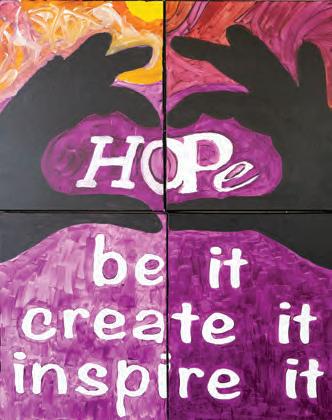
Suspected Overdose Deaths*
2018–2021
+26%
2,554 2,688 +5% 3,132 +15% YTD (Jan–Nov) Full year
2,351 2,471 2,844 3,595 *Estimate of statewide medical examiner system overdose deaths; the majority become confirmed as poisoning deaths. Percent change represents year-to-date (YTD) suspected overdose deaths compared to YTD total of previous year, based on available data at time of publication. Source: NC Office of the Chief Medical Examiner
Treatment centers have also proliferated. At first, abstinence-based treatments centers were the only centers available. Now, medicated assistant treatment centers are available in nearly every county of North Carolina. Abstinence-based treatment programs follow a model that is similar to Alcoholics Anonymous’ 12-step program. The people in recovery stop taking the drugs, and work through withdrawal with counseling and support from peers. Medicated assistance treatments also involve counseling and peer-support, but these treatment programs curb the symptoms of withdrawal by reducing their severity.
Both treatments work, but patients need to get to the treatment first. More local resources, as well as work to remove the stigma of substance use disorders, are making a difference.
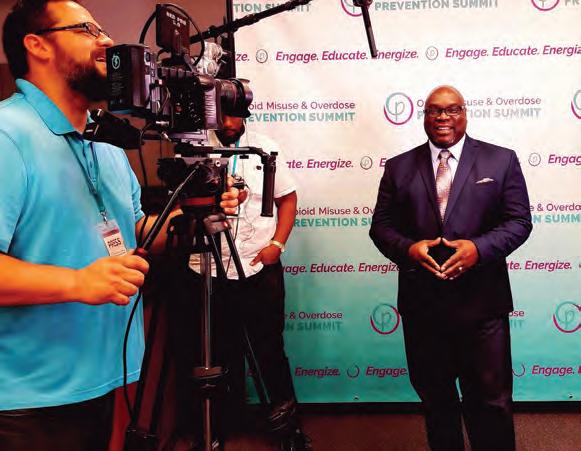
Mobilizing community
Drug Free Moore County (DFMC), which has received funding support from Central Electric, the electric cooperative based in Sanford, is a nonprofit coalition with the mission of providing educational resources, treatment information and addiction recovery support. It was organized in 1989, but with the onset of the opioid crisis has ramped up its efforts from prevention programs for school students to providing recovery support to families who are affected by substance use disorder.
DFMC Director Karen Wicker recently opened a community recovery center called Moore ReCreations in Carthage to help provide a variety of support and resources to individuals and families. The center’s goal is to help individuals “recreate” themselves during their recovery.
Moore ReCreations provides peer support services, a safe syringe program, and recovery support groups in person and via Zoom through the Moore County Detention Center. Future plans include a family support group, a reentry support group for inmates, recovery yoga, a community garden, sewing classes and other opportunities for growth and healing. DFMC is also working to provide a medically assisted treatment (MAT) program at the center through a contract with a locally established MAT program.
Karen is no stranger to the ravages of the opioid crisis. Like many, she has personal experience with opioid addiction in her family. It started innocently enough, with her daughter’s adolescent anxiety issue bringing drugs into her life as doctor-prescribed treatment.
“This, combined with peer pressure and the grief suffered from the death of her brother when she was 18, started a slow but downward spiral,” Karen explains. “There are different paths to substance use disorder, and there are different paths to recovery, too. As a parent it is hard to pinpoint what is going on until something dramatic happens.”
For Karen, it was when she received one of the worst phone calls any parent could imagine: her daughter had been air-lifted to Chapel Hill following a head-on collision. Her status was unknown. It wasn’t until several weeks later they learned substances were involved.
“When my daughter had started treatment, we did not know that, unfortunately, relapse is a part of this disease. The journey of recovery wasn’t always easy or pleasant as a parent of a loved one suffering,” Karen says. Her daughter has started a new life after being in recovery for several years. “Friends, family and people in general do not understand the heartbreak of not being able to help the one you love, or to even talk about it. Stigma is such a huge factor in families not getting the help and support they need.”
Louis Leake, who often speaks on the opioid crisis, at the 2019 Opioid Misuse and Overdose Prevention Summit in Raleigh
Taking the first step
The most important work is to remove the stigma of substance use disorders. For some, the perceived shame of addiction treatment keeps them from seeking help until it is too late.
Macon Moye, former vice president and general manager of WRFX’s John Boy and Billy network in Charlotte, first began taking pain medication for chronic knee pain. What was occasional use became daily, then became paired with alcohol. For years he refused to seek treatment until he was eventually hospitalized for more than three months.
“Two decades of drug and alcohol abuse takes a toll on your organs. They had shut down. Quit working,” he recalls of his 2012 near-death experience. Now, he is nearly a decade into recovery and supports others who are battling through recovery and the stigma associated with it through work at Chloe’s Place in Southern Pines (chloesplace.net) and at the Raleigh-based Welwynn Outpatient Center (welwynn.com).
Macon urges people who are suffering from a substance use disorder to seek treatment: “Life is too short to live dulled and desensitized.”
Carolina Country Contributing Editor Gordon Byrd is a veteran who works for UNC Pembroke. While not working or writing, he spends most of his time with family and church.
Seeking help
Are you or someone you know struggling with a substance use disorder? Contact the Alcohol and Drug Council of North Carolina at 800-688-4232 or alcoholdrughelp.org.
No Taste Like Home
By Bridgette A. Lacy
On work days, Don Simmons starts at 6 a.m. ordering supplies, scheduling work shifts, and writing the daily menu on the chalkboard at Magnolia 23, his Southern cuisine restaurant in downtown Asheboro.
Throughout the day, he may wash dishes, cook the delicious pan-fried chicken, take orders and greet every customer that comes through the door of the cozy space that reminds you of your grandmother’s dining room with mirrors and pictures on the wall.
Everybody ranging from blue collar workers, families, business people and tourists eat there.
“His food is wonderful,” says Asheboro Mayor David Smith. “His fried chicken has been recognized nationally.”
Magnolia 23 opened in 2009, the same year Don retired from his position as a supervisor for Energizer Battery Inc. in Asheboro.
“The economy was rock bottom,” Don says. “But as soon as we opened, we did pretty good.”
Word of the made-from-scratch soul food and the great hospitality kept customers coming through the door. His wife, Doris, makes the melt-inyour-mouth cornbread and often runs the cash register. And ownership of the business has been passed to daughters Brittany Simmons, a physician assistant in Greensboro, and Crystal Simmons, an associate professor at SUNY Geneseo.
Don is well known beyond his restaurant and volunteers on his days off. His latest service project is organizing a free Crowder Baseball Camp, named for the late Chester Crowder of Asheboro.
“We want every kid to have a chance to play,” Don says.
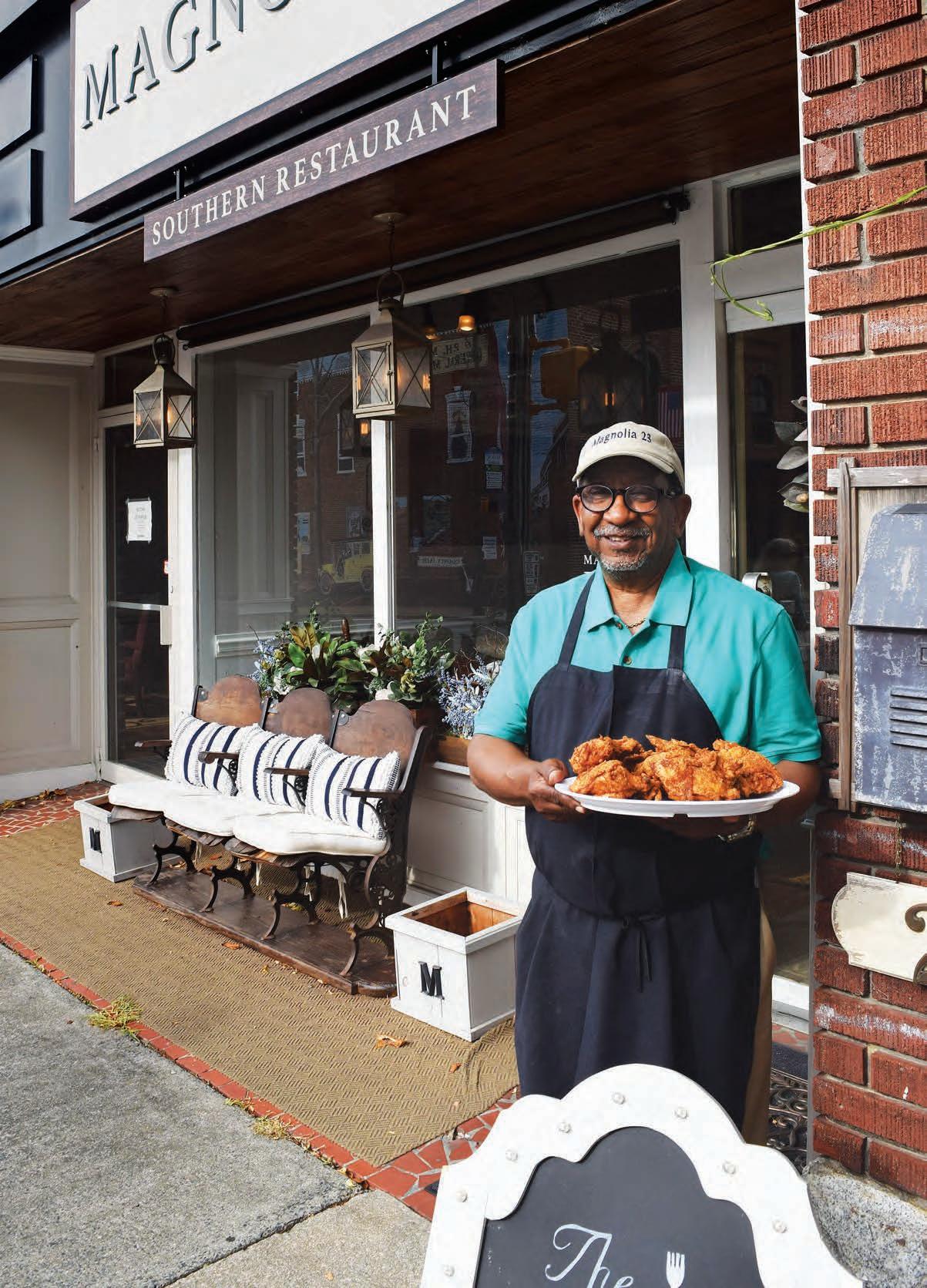
Bridgette A. Lacy (bridgettelacy@att.net) is the author of “Sunday Dinner: A Savor the South cookbook.” Don Simmons
Claim to fame: Home cookin’. Magnolia 23 was voted #63 on a list of “America’s 75 Best Fried Chicken Spots” by the Daily Meal, a website dedicated to food news. Most popular dishes: Grilled pork chops, country style steak, fried catfish, mac and cheese, collards and candied yams; desserts include fried apple pie and Hershey bar cake: a chocolate cake with white icing and pieces of Hershey’s candy sprinkles on it. Read the full version of this article at carolinacountry.com/extras
The Power of Empathy

Activities help your child develop awareness, compassion
One of the most important skills that kids can learn is empathy, the ability to understand how others are feeling and to feel compassionate toward them.
A valuable social skill that’s often the mark of a good leader, empathy aids in clear communication and helps people build positive connections with friends, family members and co-workers. Studies have demonstrated that teaching children how to empathize helps them to have healthier relationships, reduce conflict with others and build confidence.
Although some people are more naturally empathetic than others, many studies have shown that people can increase their empathy through activities that build this skill. Here are ways you can teach your child empathy:
Read together Read to your child when they are young and encourage them to keep up with the habit when they are older by stocking your shelves with books and by making regular visits to the library. Fiction books require a leap of imagination as readers put themselves in the shoes of characters, and a love of fiction can help build empathy, according to research. Award-winning children’s books that help build empathy include “Last Stop on Market Street,” “Each Kindness,” and “Hey, Little Ant.” After you read together, talk to your child about the stories and ask them what they think each character was thinking or feeling, and why. You can also do this after watching movies and television shows together, too.
Introduce interactive toys Interactive toys can foster your child’s nurturing skills. There are many fun toys on the market that double as empathy building tools, such as Hope the Healing Husky, a robotic dog that tells you how she’s feeling. She makes different sounds to show if she’s hungry, has a cold or fever, has a hurt leg or feels itchy. Kids can check her temperature, give a healing shot, bandage her “ouchie” and put on her recovery collar to help her heal. For more information about Hope, visit vtechkids.com. Play pretend Whether playing house or playing superheroes, role play is not only a chance to build worlds and be creative, but also to consider the feelings of someone else and act them out. You can encourage your child to play pretend by suggesting the activity and letting them invent the game.
Keep kids inspired with a fun costume trunk full of hats, wigs, moustaches and other accessories.
Model it Being empathetic with your child helps them become empathetic. Ask them questions about their day. What was a good thing that happened? What was hard? Listen actively. Giving hugs when your child is sad, high fives when they are glad, and being kind when your child has made a mistake are other positive ways to cultivate their own empathy.
—Statepoint.net
Working at Home
‘New normal’ requires boundaries, creativity
By Pamela A. Keene
With COVID-19, the world changed radically. From maskwearing and handwashing to working remotely, there’s no doubt a new set of stressors has made its way into the work world.
Creating a home office comes with its own challenges: finding a dedicated space that doesn’t interfere with family activities and accommodating the amount of filing and office supplies needed.
“Many people simply don’t have the space to designate a room for an office, but they may be able to carve out an area that’s not typically used during the day,” says Rose Molz, owner of EZ Office Products in Madison, Wisconsin. “In that case, using furniture — a large desk, a computer table and good seating — can help delineate the area.”
It helps when a worker sets boundaries. For example, she suggests asking family members to act as though working moms and dads are away at the office and not accessible during the day, except at specific times.
“If the home office is not in the center of family activities, this is easier to accomplish,” Rose says. “Lunchtime can provide an opportunity for family interaction and a chance to get away from the ‘office’ for a bit.”
The bright side Think: No time wasted in traffic. The ability to be home to care for a sick family member and still work. Coming to work in your pajamas. Being able to eat lunch at home and save money. Instituting flex time to offset personal necessities such as doctors’ appointments, then making up the time after dinner.
“Just be sure that you’re being fair and communicating with your employer and workmates as necessary,” Rose says. “Research has shown that working at home can be more efficient than going into the office every day, but it is important to respect your employer and supervisor’s expectations of your workday. Workspace hacks Rose offers these tips to create a successful home office:


■ Invest in a good chair. According to
Science Daily, the average working person spends approximately 5 hours and 41 minutes sitting at a desk each day, resulting in sore backs, neck strains and negative effects on the neuromuscular system. An ergonomic adjustable chair that’s truly suited to your height, weight and build will help reduce these and other ailments as well as provide a comfortable place to work. ■ Install proper lighting at your desk and computer areas. Work to eliminate strong shadows and choose lighting that’s easier on your eyes. Good lighting can supplement natural light and prevent workers from feeling isolated. ■ Purchase a chair mat. It’s much easier to roll a desk chair on a mat across carpet, and your body will thank you. Even with hardwoods, those floors need protection.
Pamela A. Keene is a freelance journalist who writes for magazines and newspapers across the Southeast and nationally.
February 2022
South River EMC Communicator
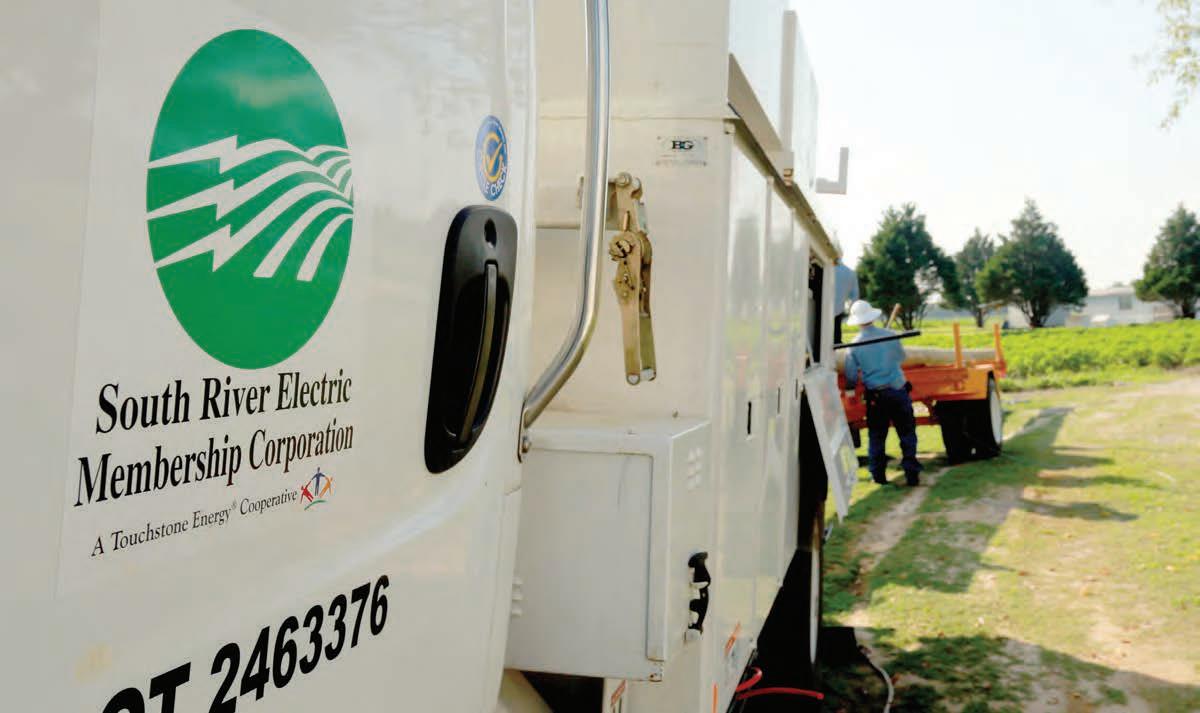
TAP INTO WAYS TO SAVE
South River EMC offers members numerous ways to save both energy and money, many of which can be found on our web site, sremc.com.
One such way is with our energy calculators. The calculators are a great way to learn and teach about ways to save and use energy.
The Cooperative has the following calculators for use: appliance, lighting, heat pump, space heating, phantom-load reduction, water heating, and holiday lighting.
You can learn about the basics of energy and electricity, as well as conducting a virtual energy assessment of your home.
Another great program is your HomeEnergy Profile, which can give you energy-saving information tailored to your home. To get the most out of your HomeEnergyProfile, you must answer the questions, otherwise, you will receive standardized savings tips.
But don't take our word for it, visit sremc.com/ rebates-efficiency-tips and try the calculators today.

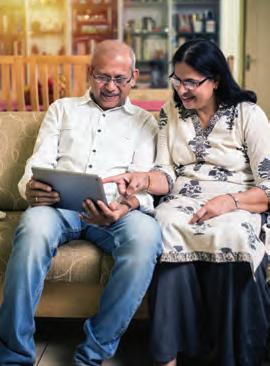
INSIDE THIS ISSUE
ORU in Review C
Director Nominations Made D
Your Opinion Matters E
Energy Smarts F-H





